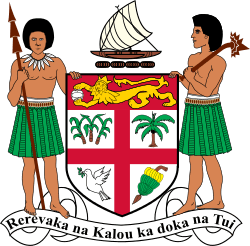1950 Fijian general election
General elections were held in Fiji in August 1950. Voting took place in most locations on 26 August, and in the Lau and Lomaiviti Islands between 21 and 28 August.[1]
 |
|---|
| This article is part of a series on the politics and government of Fiji |
|
Legislative
|
|
Judiciary
|
|
Electoral system
The Legislative Council consisted of 32 members, including 16 'official' members who were civil servants, fifteen 'unofficial' members (five Europeans, five Fijians and five Indo-Fijians), and the Governor sitting as President of the Council.
For Europeans and Indo-Fijians, three of the five representatives were elected from single-member constituencies, with the other two appointed by the Governor. All five Fijian members were appointed from a list of candidates submitted by the Great Council of Chiefs;[2] usually ten names were submitted, but as there was a tie for tenth place in the vote carried out by the Council of Chiefs in July, a list of eleven was put forward.[3]
Voting for Europeans remained restricted to men aged 21 or over who had been born to European parents (or a European father and was able to read, speak and write English), who were British subjects and had been continuously resident in Fiji for 12 months, and who either owned at least £20 of freehold or leasehold property or had an annual income of at least £120.[2] For Indo-Fijians, eligibility was also restricted to men aged 21 or over. They had to be a British subject or from British India, have lived continuously in the Fiji for at least two years, be able to read or write in English, Gujarati, Gurmukhi, Hindi, Tamil, Telegu or Urdu, and for the previous six months, have either owned property with an annual value of five years, had a net annual cash income of at least £75, or held a Government or municipal licence worth at least £5 annually.[2]
Results
In the Eastern European constituency, Harold Brockett Gibson defeated the incumbent Fred Archibald by eleven votes, whilst in the Eastern Indian constituency James Madhavan beat J. B. Tularam by a margin of 368 votes.[4]
| Constituency | Candidate | Votes | % | Notes |
|---|---|---|---|---|
| European members | ||||
| Eastern | Harold Brockett Gibson | Elected | ||
| Fred Archibald | Unseated | |||
| Northern and Western | Maurice Scott | Unopposed | Re-elected | |
| Southern | Alport Barker | 316 | Elected | |
| Amie Ragg | 182 | Unseated | ||
| Robert Spowart | 174 | |||
| Indo-Fijian members | ||||
| Eastern | James Madhavan | Re-elected | ||
| J. B. Tularam | ||||
| Northern and Western | Tulsi Ram Sharma | 2,340 | Elected | |
| A. D. Patel | 1,858 | Unseated | ||
| Southern | Vishnu Deo | 1,681 | Re-elected | |
| Hari Charan | 1,446 | |||
| Source: Pacific Islands Monthly | ||||
Nominated members
| Europeans |
|---|
| Clive Elliot |
| Harold Gatty |
| Fijians |
| Edward Cakobau |
| George Cakobau |
| George Toganivalu |
| George Tuisawau |
| Ravuama Vunivalu |
| Indo-Fijians |
| Sadanand Maharaj |
| Ben Jannif |
| Source: Fiji Elections, Fiji Royal Gazette[5] |
Aftermath
Edward Cakobau resigned from the Council in 1952 and was replaced by Tiale Vuiyasawa.[6]
References
- August 26 is Fiji Election Day Pacific Islands Monthly, August 1950, p14
- 1940 Legislative Council Election Fiji Elections Archive
- Fijian Members of Legislative Council Pacific Islands Monthly, August 1950, p86
- Fiji elections: Changes in the Council Pacific Islands Monthly, September 1950, p7
- Fiji Royal Gazette: Year 1950, p243
- Ratu Tiale Vuiyasawa Pacific Islands Monthly, February 1952, p57